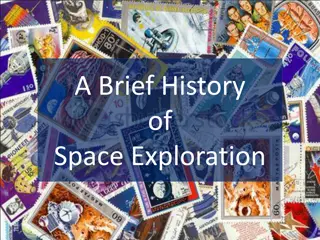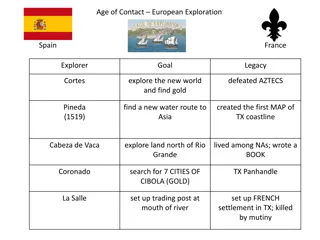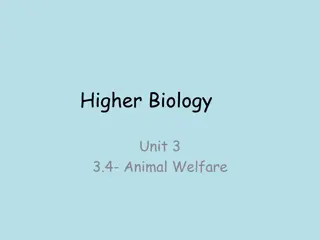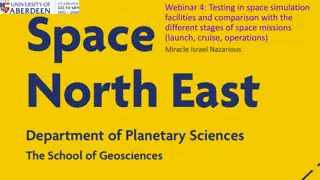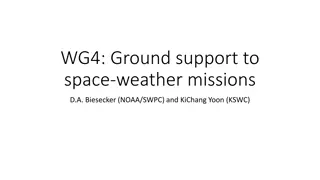Exploring Space: Pioneers, Missions, and the Role of Animals
Humans have a rich history of space exploration, with notable milestones including Yuri Gagarin's orbit in 1961, the Apollo 8 moon mission, and Sally Ride becoming the first American woman in space. Before human space travel, animals played a crucial role in understanding the effects of space on living organisms. Space begins at an altitude of 100 km, with sub-orbital flights exceeding this boundary. The boundary between Earth's atmosphere and outer space is known as the Kármán Line. Scientists used animals to study biological effects, stress, and technology for space travel.
Download Presentation

Please find below an Image/Link to download the presentation.
The content on the website is provided AS IS for your information and personal use only. It may not be sold, licensed, or shared on other websites without obtaining consent from the author. Download presentation by click this link. If you encounter any issues during the download, it is possible that the publisher has removed the file from their server.
E N D
Presentation Transcript
http://www.spacetoday.org/images/Astronauts/SpaceDogs/RhesusMonkeySpacesuitNASA.jpghttp://www.spacetoday.org/images/Astronauts/SpaceDogs/RhesusMonkeySpacesuitNASA.jpg
Space is said to begin at an altitude of 100 km This point is usually referred to as the K rm n Line, the boundary between the Earth s atmosphere and outer space Outer space usually refers to the region above Earth s atmosphere There is no concrete boundary between Earth s upper atmosphere and space as the atmosphere gradually thins with increasing altitude
Sub-orbital flights reach an altitude higher than the K rm nline Sub-orbital flights usually test spacecraft and launch vehicles intended for future orbital spaceflights To enter orbit, a spacecraft must also reach orbital speed (about 7900 m/s) Orbital spaceflights have only been completed by launch vehicles using rocket engines for propulsion
On April 12, 1961, Yuri Gargarin was the first man to orbit the Earth May 5, 1961 Alan Shepardpilots the Freedom 7 and becomes the first American to travel into space John Glenn becomes the first American man to orbit Earth on February 20, 1962
Apollo 8 orbits the moon and allows the world a glimpse of Earth from outer space Neil Armstrong and Edwin Buzz Aldrin landed on the moon in 1969 Sally Ride becomes the first American woman in space on June 18, 1983
Before humans were sent into space, scientists used animals to learn more about the possible effects Because of these animals, scientists gained knowledge about The biological effects of space travel Conditions beyond the ozone layer Effects of weightlessness on living organisms Effects of stress on behavior Animals played a vital role in testing the initial spacecraft and technology needed to put humans into space
A stray dog from the streets of Moscow Nicknamed Muttnik by the American press First animal launched into orbit (November 3, 1957) Sent to space in Sputnik 2, the Soviet Union s (and the world s) second artificial space satellite
Proved that a living passenger could survive being launched into orbit and undergo weightlessness Laika died from overheating just a few hours after the mission had started On April 14, 1958, her remains (as well as Sputnik 2) disintegrated during re- entry
One of the first monkeys to travel into space Nicknamed Old Reliable Launched from Cape Canaveral in the US Jupiter AM-13 on December 13, 1958 Parachute failed and he died during landing His flight was considered a success because scientists learned that the human body could cope with weightlessness
First monkeys to survive spaceflight on May 28, 1959 Flew to an altitude of 360 miles, withstanding 38 times the normal pull of gravity and weightlessness for 9 minutes Able died 4 days after the flight from complications in surgery
Rhesus monkeys Sam lifted off on December 4, 1959 and traveled 55 miles into space Flew on the Little Joe 2 (Mercury program) to test a restraint harness that astronauts would later use Miss Sam flew to an altitude of nine miles in 1960 She tested an escape system for future Mercury manned flights Both were recovered safely
On board Sputnik 5, which was launched August 19, 1960 and became the first spacecraft to return animals alive from orbit Accompanied by 49 mice and 2 rats Recovered after spending a day in orbit One of Strelka spuppies was given to JFK
First chimpanzee launched into outer space by America Was taught to pull levers in response to flashing lights during flight Took off from Cape Canaveral on Jan. 31, 1961 Before mission was aborted due to complications, Ham traveled 155 miles in 16 minutes
Named after Holloman Aerospace Medical (HAM) center in New Mexico where he trained for his mission After the mission, Ham lived at various zoos until his death on January 19, 1983 Ham s skeleton is at AFIP s National Museum of Health and Medicine while his other remains were buried at the International Space Hall of Fame Ham III, the main character of Space Chimps, was named after Ham Watch a video about Ham
First chimpanzee in orbit Received more extensive training than Ham s because he would be exposed to more extreme forces Launched Nov. 29, 1961 in a Mercury capsule Completed two orbits before coming back down His success led to John Glenn s mission in 1962
Launched on February 22, 1966 Spent 22 days in obit on board Cosmos 110, setting the record for the longest space flight by dogs Used to study the prolonged effects of radiation from the Van Allen Belts Observed via video transmission and biomedical telemetry
Arabella, a garden spider, was placed on Skylab 3 in 1973 She was part of an experiment to determine if the webs spiders wove in space differed from the ones woven on Earth Scientists discovered that the webs from space had slight differences most likely due to gravity (or lack of)
On April 28, 1985, the shuttle Challenger was launched with Spacelab on board Spacelab contained monkeys, rats, as well as other animals under observation One monkey adapted quickly to microgravity, while the other exhibited symptoms of Space Adaptation Syndrome Animals were returned to Earth alive and well
Space Shuttles reusable crafts that transport satellites, astronauts, animals, and other materials to and from space Space Station permanent outpost in orbit that provides astronauts and scientists a place to study the effects of space on animals International Space Station Skylab Mir
Are considered the real pioneers of space flight Continue to help scientists gain a better understanding of space and its effect on living organisms
Video: History of Space Exploration Quiz: Early Space Missions Quiz: Current and Future Space Missions Games: Space Activities Astronomy for Kids
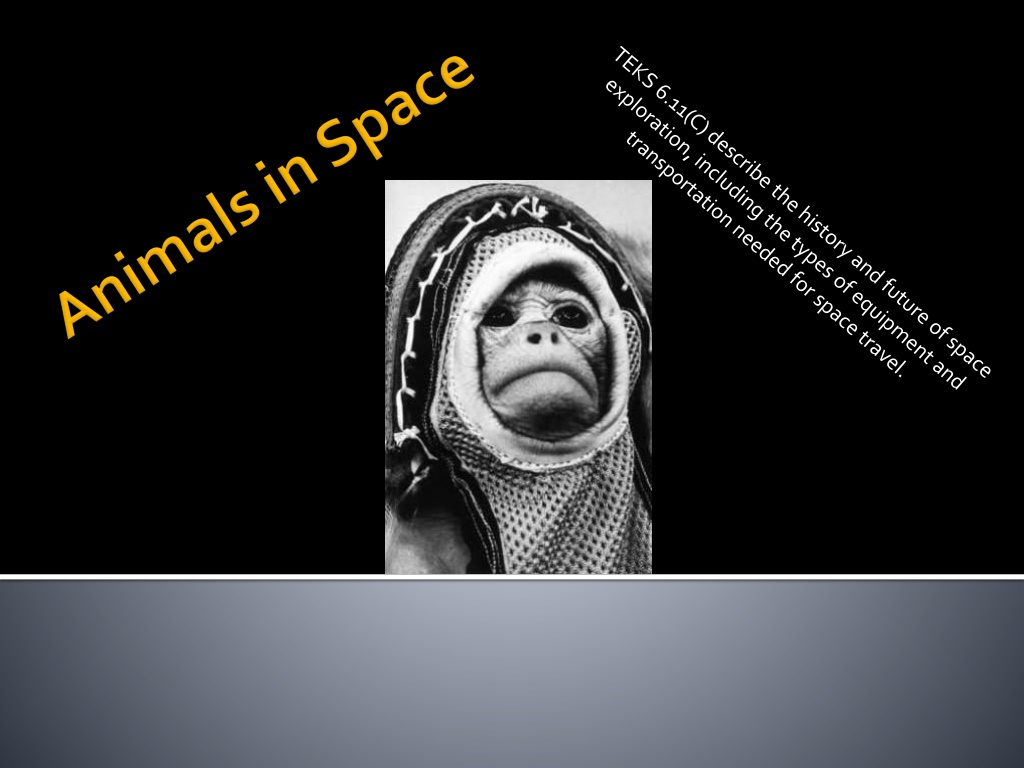

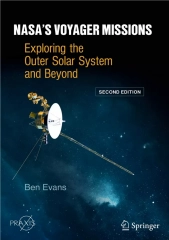
![Read⚡ebook✔[PDF] The Untold Stories of the Space Shuttle Program: Unfulfilled D](/thumb/21685/read-ebook-pdf-the-untold-stories-of-the-space-shuttle-program-unfulfilled-d.jpg)





